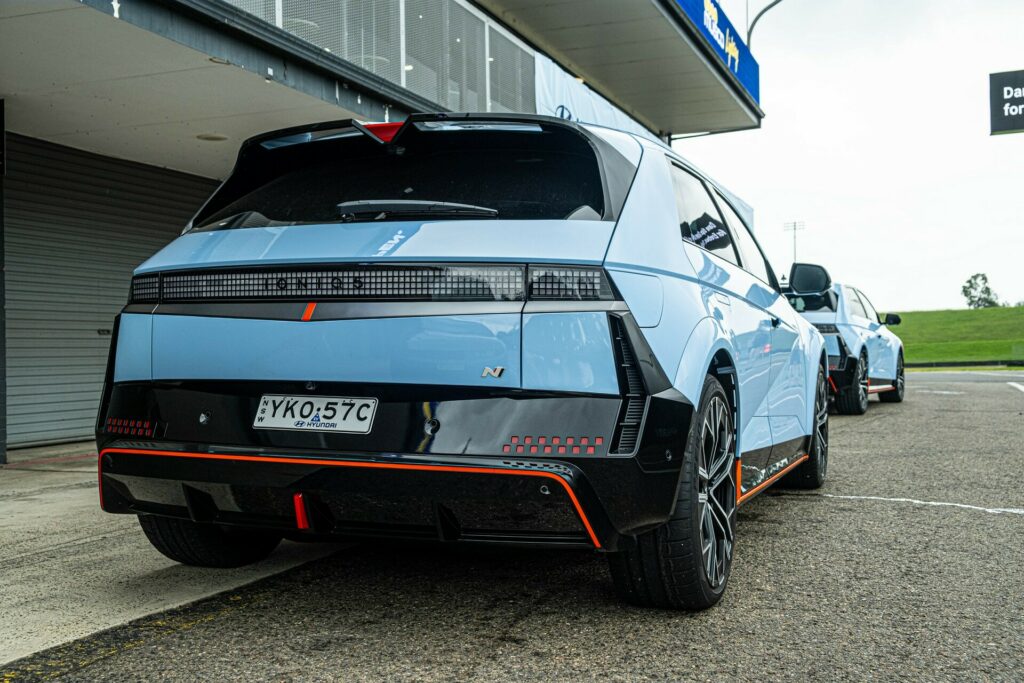 –>
–> 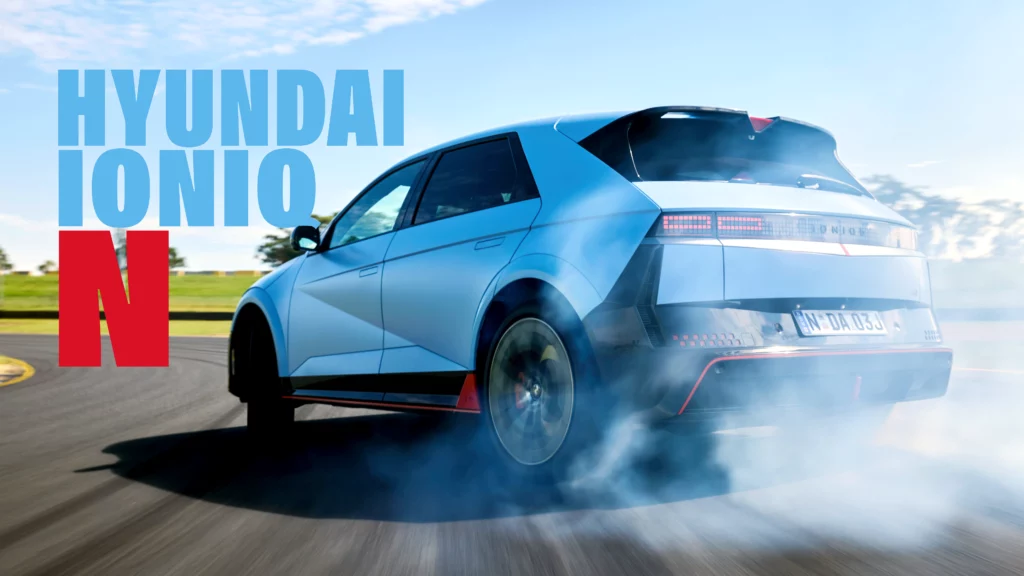
The Ioniq 5 N proves that car enthusiasts should no longer fear the EV revolution
March 7, 2024 at 08:01
–>
Pin the throttle, let the engine rev out, and pull the paddle to the dual-clutch transmission. Turn in, clip the apex, and accelerate out. These were the thoughts running through my head while lapping the fabulous Sydney Motorsport Park with the Hyundai Ioniq 5 N. It was only while powering down the main straight at over 230 km/h (143 mph) when I remembered this is no ordinary N car.
There is no engine. There is no dual-clutch transmission. This is an EV weighing 2,200 kg (4,850 lbs) and yet, when driving at ten-tenths, it feels just as engaging and raucous as the i30 N, providing all the same sounds and giving you the same kick during shifts. There is no other EV on the market quite like this one.
A new dawn of performance
The car industry is in a fascinating period as companies shift towards electrification and soon, the world of combustion-period hot hatches will be dead. In recent years, vehicles like this have become the specialty of Hyundai’s N division, with the i20 N, i30 N hatch, and i30 Sedan N/Elantra N praised by journalists and buyers alike. With the Ioniq 5 N, Hyundai hopes to capture some of the essence of its hot hatches into a bigger and heavier package powered solely by electricity.
advertisement scroll to continue
Photos Brad Anderson / Carscoops and Hyundai Australia
Quick facts
You see, designing, developing, and producing an EV with earth-shattering straight-line abilities isn’t as impressive as it was a few short years ago. Cars like the Tesla Model S Plaid, Lucid Air Sapphire, and Porsche Taycan all offer supercar-beating levels of horsepower and performance but lack the thrills and driver engagement long expected of high-performance sedans and crossovers. Hyundai N could have made its first EV a competitor to these but it has adopted a different approach, preferring to emphasize driver engagement. Has it succeeded?
In the lead-up to the Australian launch of the Ioniq 5 N early last week, we weren’t quite sure. The standard Ioniq 5 is an excellent all-rounder but it’s not a particularly thrilling car to drive. The Kia alternative to the Ioniq 5 N, the EV6 GT, is a hugely capable vehicle with blistering performance but it feels big, heavy, and lacks some of the fun and pizzazz that we were hoping for. The Ioniq 5 N is a different beast entirely.
What makes it special?
Like all current Hyundai, Genesis, and Kia EVs, the Ioniq 5 N is underpinned by the firm’s E-GMP platform. It uses an 800-volt electrical architecture and is powered by an 84 kWh battery pack, slightly larger than the 77.4 kWh pack of other Ioniq 5 models. Despite the added capacity, this new pack weighs just 3.7 kg (8.1 lbs) more than the 77.4 kWh one with the energy density rising from 160.6 Wh/kg to 173 Wh/kg.
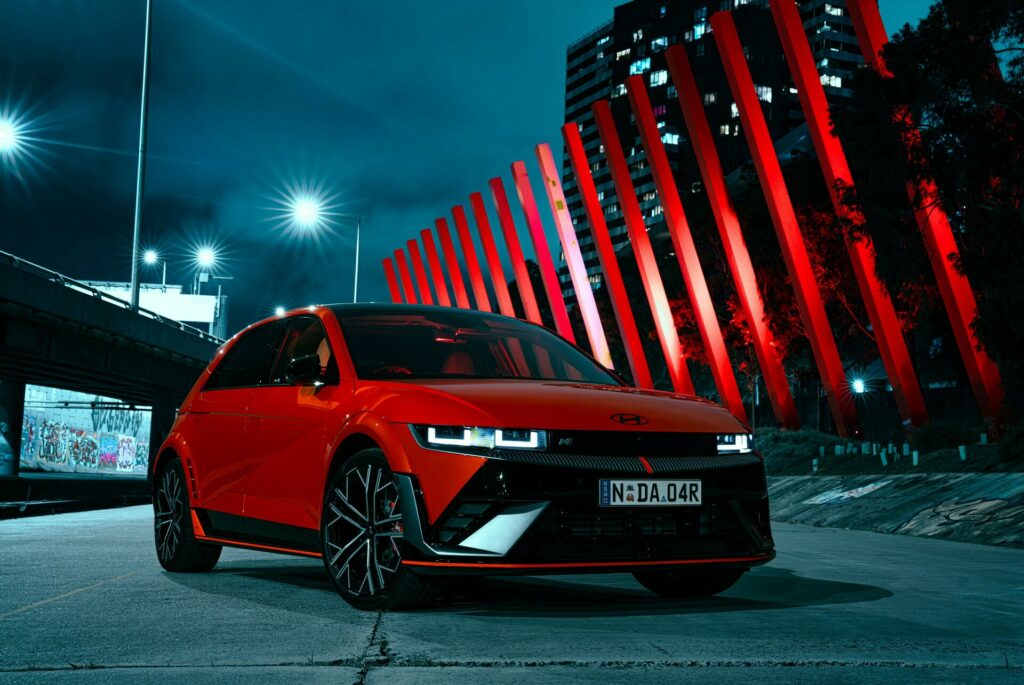
The battery pack feeds power to two electric motors. The one up front produces 175 kW (235 hp) and 370 Nm (273 lb-ft) of torque while the rear motor is rated at 303 kW (406 hp) and 400 Nm (295 lb-ft). During regular driving, the motors combine to produce 448 kW (601 hp) but this figure increases to 478 kW (641 hp) with the N Grin Boost function enabled for 10-second bursts. Hyundai says the car needs just 3.4 seconds to hit 100 km/h (62 mph).
Read: 2025 Hyundai Ioniq 5 Facelift Debuts With Larger Battery And New N Line Trim
Our time with the car started just outside Sydney for a drive through the Yengo National Park to the tiny town of Laguna. The drive included a mix of city driving, highway cruising, and blasts along a thrilling mountain road, providing us with the opportunity to assess the breadth of the car’s abilities.
Visually, there is no mistaking the Ioniq 5 N for the regular model. First are the colors. It is available in a host of exclusive hues, including N’s signature Performance Blue, Soultronic Orange, Atlas White Matte, Ecotronic Grey Matte, Gravity Gold, and Performance Blue Matte, the color of our test car. All examples come standard with Luminous Orange accents across the front splitter, side skirts, and rear diffuser.
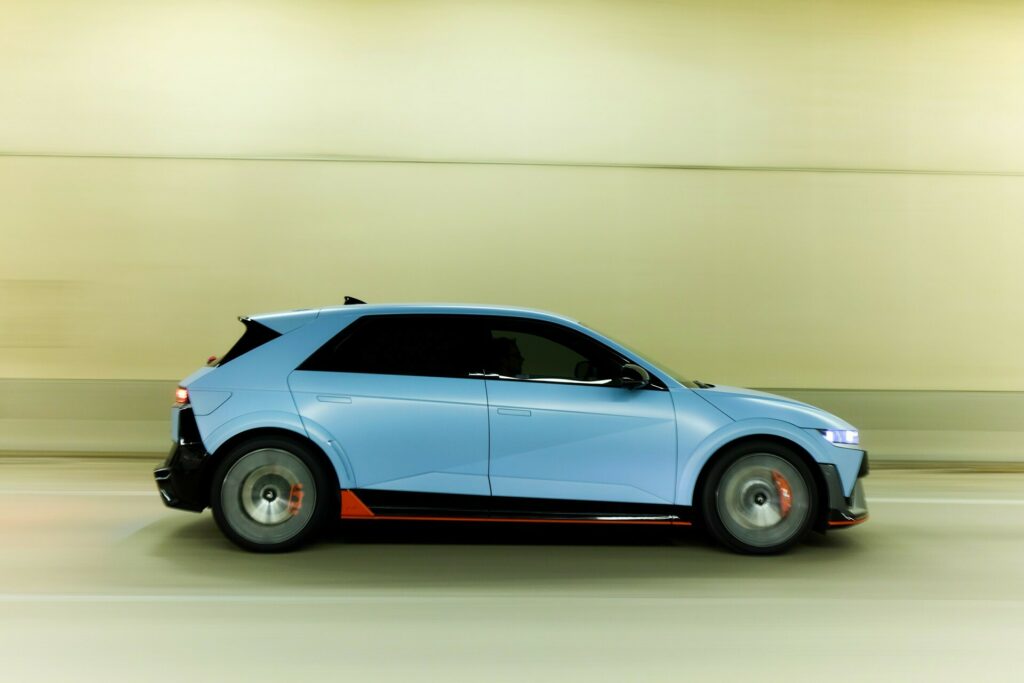
Hyundai’s engineers have also done plenty to add to the car’s aggression. The front end has been thoroughly revised with a new grille, air intakes, and aerodynamic aids while the sides include new skirts and 21-inch forged aluminum wheels. Found at the back is a pronounced spoiler, a rear wiper, and a diffuser.
There are plenty of changes going on inside the cabin, too. One of the most significant upgrades made is the fitment of an N-exclusive steering wheel that includes two customizable N buttons, a Drive Mode switch, and a button to engage N Grin Shift. A new fixed center console has also been fitted to provide the driver and passenger with additional thigh support during cornering. Unique pedals have also been installed as have plenty of Performance Blue inserts, including contrasting stitching on the seats.
advertisement scroll to continue
Photos Brad Anderson / Carscoops and Hyundai Australia
Under the skin
While the updated looks and interior are nice, these alterations are inconsequential in the broader context of the Ioniq 5 N. It is under the skin where the more significant changes have been made and it is these upgrades that have transformed the electric hatch/crossover into the most engaging EV on sale.
Hyundai N’s engineers started with the car’s chassis, adding 42 additional welding points and 2.1 m (6.8 feet) of extra adhesive to improve strength and reduce flex. It has also strengthened the suspension mounting points, added four new underbody mounts, and two front cowl cross bar mount points. The torsional strength of the body-in-white is up by 11%.
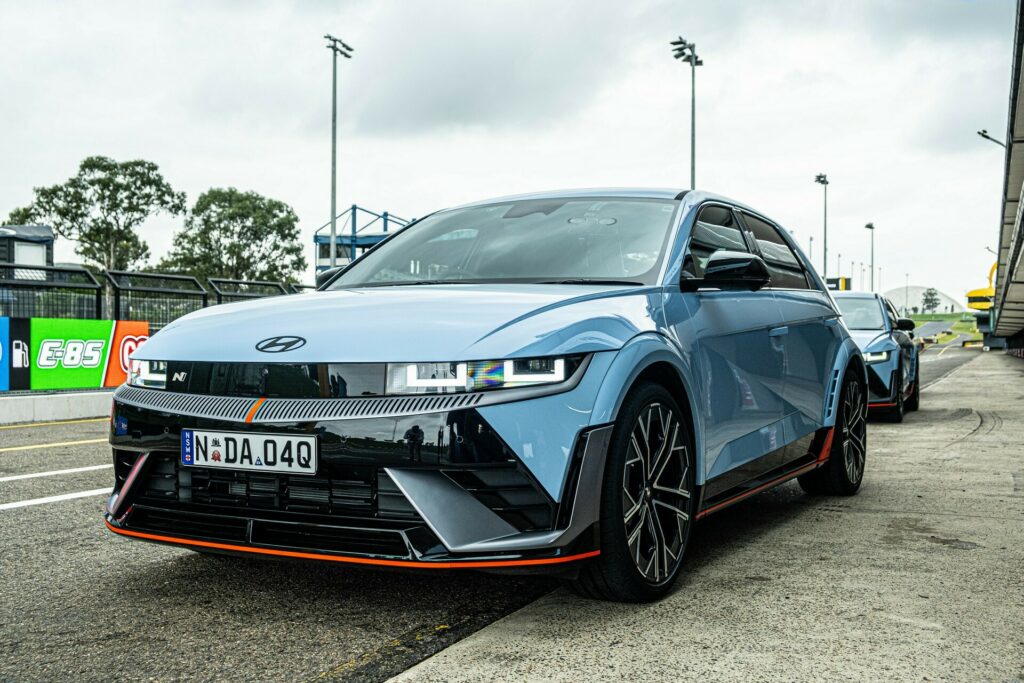
Next, Hyundai fitted revised front and rear integrated drive axles, a dual axis hydro type motor mount bush to provide improved response and comfort, and installed a new rack-mount motor driven power steering system. The Ioniq 5 N also includes an electronic limited-slip differential and electronic controlled suspension which has been customized to suit Australian roads. Huge new brakes also come standard, consisting of 400 mm (15.7-inch) front discs with four-piston calipers and 360 mm (14.2-inch) rear discs with single-piston calipers. The regenerative braking system has also been improved and can generate up to 0.6G of braking force alone while still feeding energy back into the battery during ABS braking, an industry first.
Read: Hyundai N Wants To Be The King Of ‘Fun Per Dollar’ Cars
Then there are the slew of driver-focused technologies. These include N Torque Distribution that allows you to customize how much power is going to the front and rear wheels, an N Drift Optimiser to help you easily hold powerslides, N Launch Control that can be adjusted to suit road grip levels, and an N Race mode with Sprint and Endurance settings to either deliver the maximum performance or conserve power and torque outputs for longer track stints.
Perhaps the two most intriguing features of the car is N Active Sound+ and N e-Shift. The first of these systems includes three sound profiles to add to the driving experience. These consist of Ignition, designed to mimic the sound of N’s combustion cars, Evolution, which has a futuristic EV sound inspired by the RN22e, and N Vision Gran Turismo and Supersonic, which aims to mimic the sound of a fighter jet.
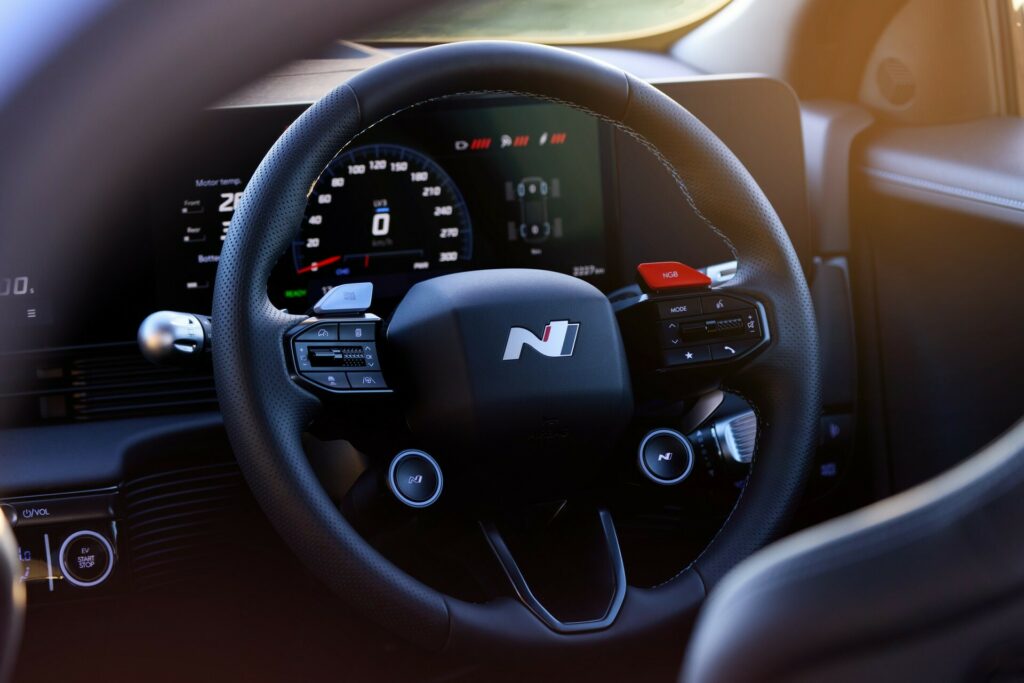
N e-Shift is an electronically controlled version of N’s eight-speed dual-clutch transmission. While the Ioniq 5 N only has one gear, the engineer who calibrated the firm’s DCT worked to mimic this system on the EV, allowing drivers to use the paddles to shift between gears as if they were driving a car with a normal transmission.
No other EV drives quite like this
On the road, the most powerful and expensive production car ever produced by Hyundai ticks all the boxes.
Much like the brand’s other N models, it is just as comfortable to drive around the city and on the highway as the standard model it is based on. There are plenty of safety features to make driving stress-free, including lane-keep assist, lane following assist, adaptive cruise control, and a lane-changing assistant that allows you to change lanes with a simple flick of the indicator stalk. Like most other EVs, it’s extraordinarily quiet when you want it to be. However, you probably want to know what it’s like to drive at speed, right?
After a 45-minute blast along the highway, we turned off to Great N Rd. heading North, switched the Ioniq 5 N into the first of two N Custom modes, enabled the N e-Shift function, and switched on the Ignition sound profile. The car’s character instantly shifted from a comfortable cruiser into a manic road warrior capable of cornering at frightening speeds and leaving you gasping for air from the acceleration.
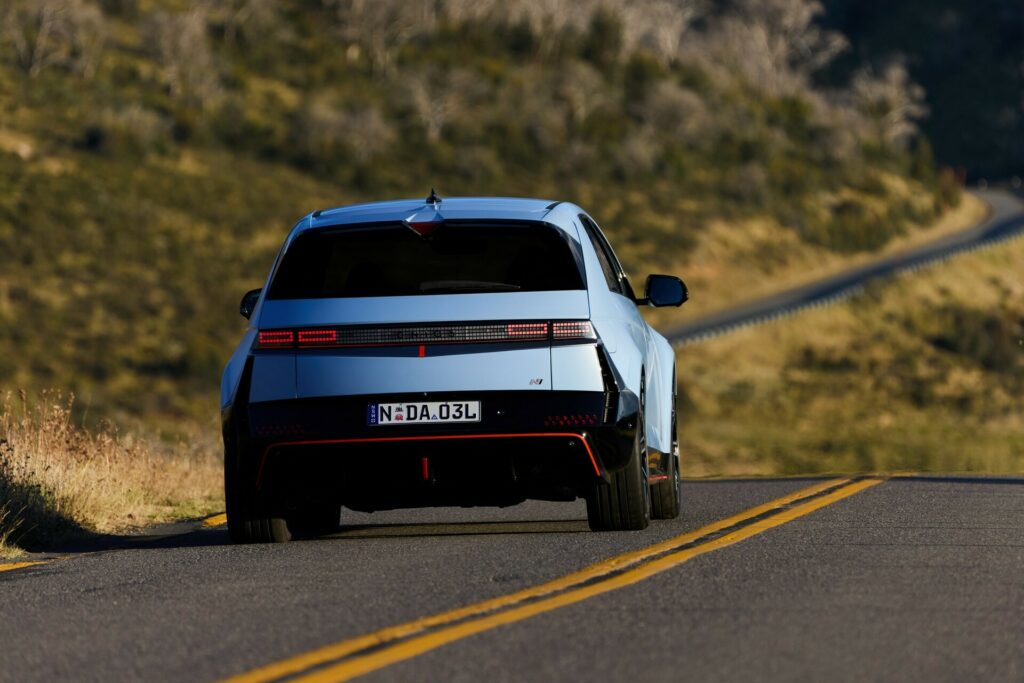
The highlight of the driving experience is the N e-Shift system. In theory, equipping an EV with a synthetic dual-clutch transmission seems stupid and many keyboard warriors proclaim Hyundai was silly to develop such a system. Trust me when I say this, it redefines what an EV can be.
The N division has developed the shift function so well that it feels exactly the same as a true DCT in an i30 N. That means that on every shift you get hit with a solid thump in the back as the systems briefly cut power to the wheels, pretend to change cogs, and fire you back down the road. If you choose, you can bounce it off the fake rev limiter or drive it in a more precise and controlled manner. If I were to use the system blindfolded, I’d be hard-pressed to notice any difference between it and a DCT.
Photos Brad Anderson / Carscoops and Hyundai Australia
Then there’s the sound. Hyundai N chief technical advisor doesn’t care for the Evolution and Supersonic sound profiles of the Ioniq 5 N, nor do we. However, we did thoroughly enjoy the Ignition option. This system uses eight internal speakers and two external speakers to mimic the sound of Hyundai’s other N models. At a standstill, the sound is quite fake but once you’re on the move, it becomes more believable, emitting all the same cracks and pops we’ve come to expect from an N model. It does not mimic the real soundtrack as well as the N e-Shift mimics a DCT but it’s certainly the most compelling synthetic soundtrack of any EV we’ve experienced.
All Ioniq 5 N models come equipped with Pirelli P-Zero HN tires measuring 275/35 at all four corners. These tires perform well in all conditions, remain quiet on the highway, and provide significant traction when you’re driving hard. The brakes are another highlight. Unlike some other brands, Hyundai’s engineers have done a fine job of meshing together the regenerative braking system with the mechanical brakes with a smooth transition between them.
Photos Brad Anderson / Carscoops and Hyundai Australia
A track beast
For as compelling as the Ioniq 5 N is on the road, it is a car that cannot be fully enjoyed until driven on a racetrack. It’s fitting then that we spent our second day with the car at Sydney Motorsport Park, pushing it to its absolute limits.
The straight-line performance of the car is mind-bending, particularly when left in ‘automatic’ mode and with the N Grin Boost function enabled. It fires out of corners at frightening speeds and before you have a second to think, you’re at the next corner and jumping hard on the brakes. With the N e-Shift function turned on, the performance feels a little more restrained but it is still noticeably quicker than a combustion N car.
Read: Hyundai N’s Number 1 Priority Is An Affordable Performance EV
A crossover with a 3,000 mm (118-inch) wheelbase and weighing 2,200 kg (4,850 lbs) should feel loose and floppy on a circuit. The Ioniq 5 N doesn’t. The steering is precise, the grip is immense, and it hides its weight very well. In fact, it only feels a touch heavier than an i30 Sedan N when in reality, it’s more than 700 kg (1,543 lbs) heavier.
The balance is great. This is N’s first model with all-wheel drive and with the N Torque Distribution set to 50:50, it feels light and playful on its feet. If you enter a corner a little too hard, it can be pushed into understeer but that can be cured with a healthy dose of throttle that will kick the tail around. Even with all the traction and stability control systems enabled, there were multiple instances when we had to apply a dab of opposite lock to avoid getting too sideways and lighting up the rear tires.
Photos Brad Anderson / Carscoops and Hyundai Australia
Throughout our time with the car, Hyundai’s engineers repeatedly told us that adding some playfulness to it was hugely important. This is not a car about ultimate lap times and that’s very much what it feels like. Around Sydney Motorsport Park, we suspect it is only a couple of seconds quicker than an i30 Sedan N as we noticed similar corner speeds to those we achieved with the sedan at December’s N Festival. Where the Ioniq 5 N shines is when it is driven at its limit and thrown around a corner, with an obvious emphasis placed on the driver managing the oversteer you get when hitting the throttle a little too early. It’s not just playful but it is incredibly engaging to drive, hence why I found myself forgetting that I was driving an EV and not a 600 hp ICE hot hatch.
And the range?
In the coming few months, we will have the opportunity to drive the Ioniq 5 N for a week and be able to better report on what it is to live like. One thing we can say for certain is that the range suffers when you drive this thing hard. Hyundai says it can travel up to 448 km (278 miles) on a charge but when we returned from our ~280 km (174-mile) roundtrip through Sydney and the nearby mountains, the battery was down to 15%. Fortunately, it can be hooked up to a 350 kW charger and reach peaking charging speeds of just over 240 kW, allowing the battery to be charged from 10-80% in just 18 minutes.
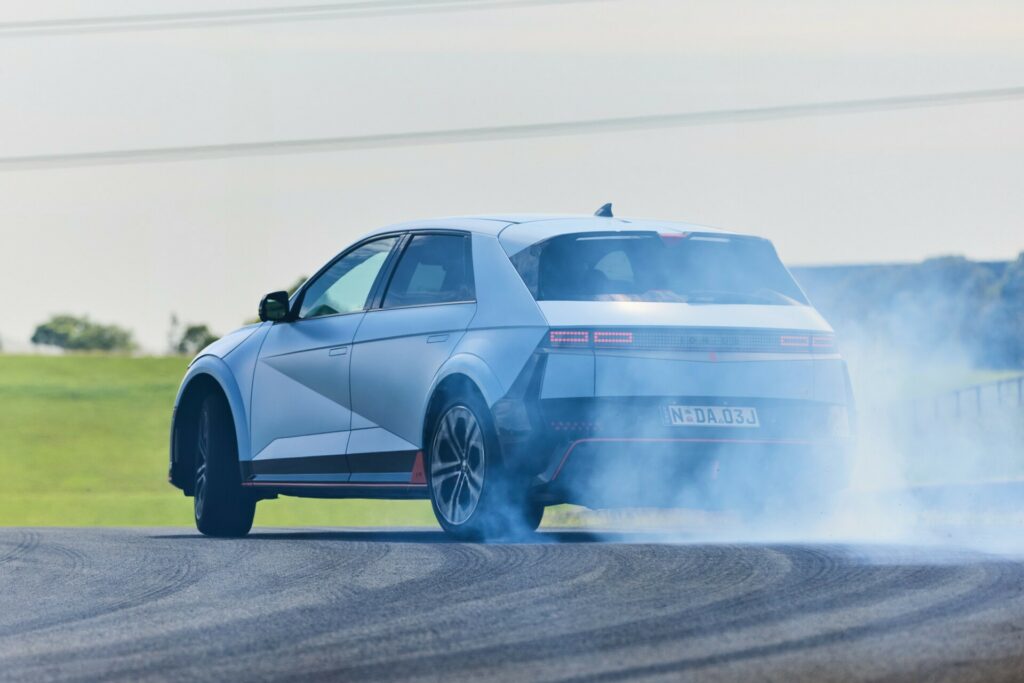
The strength of the car’s charging abilities was on full display at Sydney Motorsport Park. After 20 minutes or so of hard track driving, the cars were taken to a pair of nearby 150 kW chargers, plugged in for 20 minutes, and were then ready for another 20 minutes of track driving. Track-day enthusiasts need not worry.
Should I buy one?
The Hyundai Ioniq 5 N is a remarkable feat of engineering. Yes, it may be pricey, but it jams a dizzying array of impressive technologies and features into a retro-themed package that no other carmakers have been able to achieve, including Kia with the EV6 GT. Is it twice the car of an i30 N or twice as fun to drive? No. But if you have your heart set of an EV that is thrilling to drive, this is the one to get.
